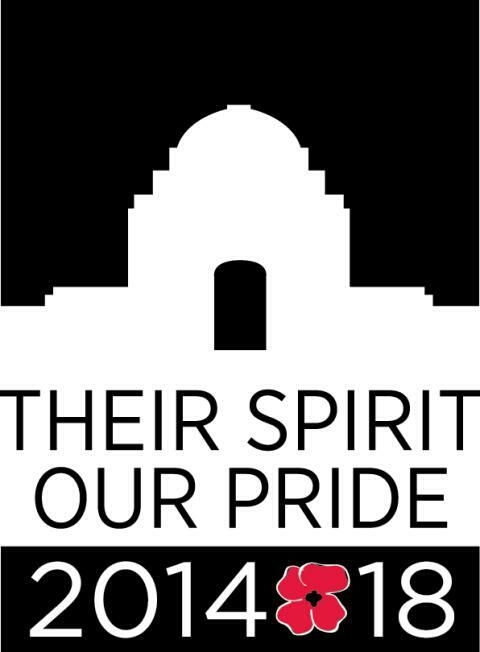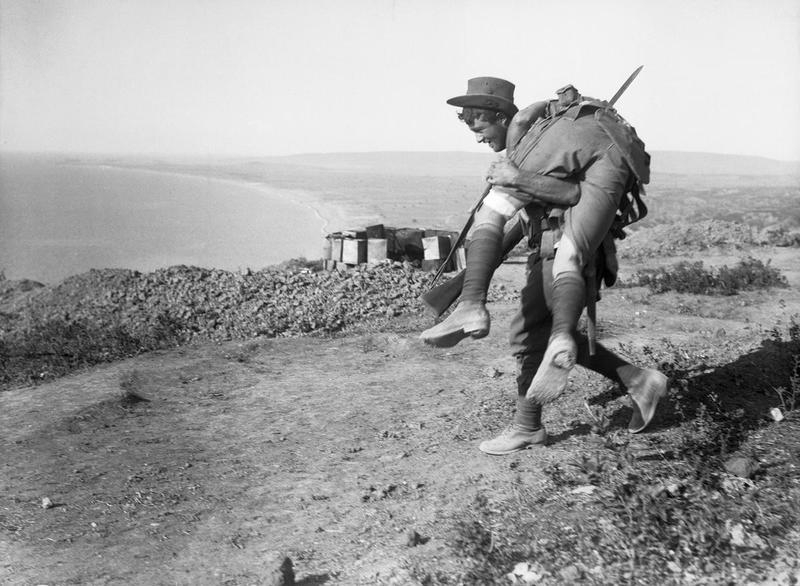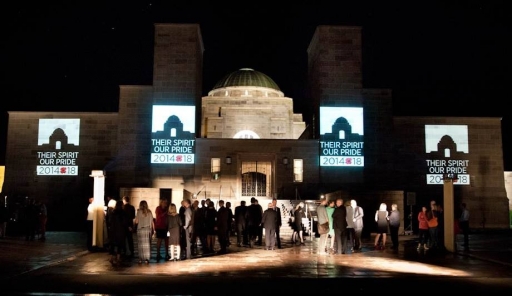The Australian War Memorial has announced a series of events and exhibitions to mark the Centenary of the First World War, which will include the names of Australia’s First World War dead being projected onto the Memorial.
The names of all 62,000 Australians who died during the conflict will be projected onto the Australian War Memorial throughout the Centenary period repeatedly in a continual Roll of Honour.
Major exhibitions, extended Anzac Day services and crosses with messages from children written on them – to be placed on the graves of Australian First World War dead abroad – are all part of the Memorial’s four year programme to mark the 100th anniversary of the conflict.
Announcing the plans on the 19th February 2014, the Director of the Australian War Memorial, Dr. Brendan Nelson, said that the Centenary is “a commemoration of who we are”.
“Their Spirit, Our Pride”
The programme was launched with the theme of ‘Their Spirit, Our Pride’, which also features on the AWM’s Centenary logo.
 The Australian War Memorial’s Centenary logo
The Australian War Memorial’s Centenary logo
The logo has been created bearing in mind the words of one of the visionaries behind establishing the Australian War Memorial, Charles Bean: “Here is their spirit, in the heart of the land they loved; and here we guard the record which they themselves made”.
Dr. Nelson stated at the launch that the Centenary “is not a celebration”, but that “it will be a commemoration”.
Veteran Affairs’ Minister, Michael Ronaldson, said that the 100th anniversary of the conflict provided an opportunity for Australians to “honour the extraordinary deeds of ordinary men and women, men and women who did not go to battle to seek glory, but who by their deeds and actions achieved greatness”.
Exhibitions
A major redevelopment of the Memorial’s First World War galleries, in order to “rejuvinate and modernise” them, will see dioramas – some not seen in public since the 1980s – on display. Two of these dioramas – Semakh and Desert Patrol – will highlight Australia’s desert campaigns during the conflict in places such as Palestine.
There will also be a much clearer chronological basis to the exhibitions than before. Historic items which have been held in storage will once again be placed on show in the galleries, together with significant newly-acquired items such as a 4.5 Howitzer and relics from the 2010 excavations at the Pheasant Wood mass grave site.
The redeveloped galleries, which will showcase more than 1,600 items from the National Collection, will open in December 2014 to the public.
Artist’s impression of the new First World War galleries
Two other major exhibitions, which are already open to the public, have seen letters written by those who fought in the war on display, as well as a major digitisation project.
Anzac Voices was opened in 2013 and presents a series of letters, diaries and other primary documents written by those who served during the conflict. It will remain open until November 2014.
Anzac Connections is a large scale digitisation of the Memorial’s historic documents, which has been undertaken to make them available online to all Australians. The first tranche of one hundred diaries and letters was made available in December 2013, with more being released throughout the Centenary period.
During 2016-2018 an exhibition entitled Mad Photographers will explore the Memorial’s collection of photographs produced in 1917 by Frank Hurley and Hubert Wilkins.
Their arrival on the Western Front coincided with the Flanders offensive which involved five Australian divisions and resulted in 12,000 of their deaths.
Travelling Exhibition
Beyond Australia’s capital city of Canberra, where the AWM stands, a travelling photographic exhibition will tour the country in 2014-15.
Showcasing iconic, as well as previously unpublished photos of Anzac soldiers, which were taken during the Gallipoli Campaign, the exhibition will also explore the life of the man behind the camera – Charles Ryan.
Commencing in August 2014, the exhibition will also be made available in a digital format.
Commemorative crosses
Based on a 2013 initiative, which saw 2,000 commemorative crosses with messages inscribed on them by schoolchildren placed on the graves of Australia’s overseas First World War dead, the AWM has extended this to mark the Centenary.
The Memorial plans to capture in young people’s own words their reflections on the war and thoughts about Australians who have given their lives in conflicts in the last century.
Working with the Department of Foreign Affairs and Trade, crosses will be placed on Australian war graves and memorials throughout 2014-18 in countries including Belgium, France, Greece, Malaysia, Singapore, South Africa, Turkey and in the Middle East.
A separate initiative, launched in July 2013, has seen the development of a ‘Roll of Honour Soundscape’, whereby primary school students from across Australia have recorded the name and age of each of the 62,000 Australians who died during the First World War.
These voices will be played in the AWM during the Centenary, “clearly linking our past with the next generation”.
Anzac Day 2015
To mark the 100th anniversary of the start of the Gallipoli landings, images from the campaign will be projected onto the AWM in the weeks leading up to the Centenary.

‘An Australian carrying his wounded mate to a medical aid post for treatment, Gallipoli, 1915’, courtesy of the Imperial War Museum, IWM, Q 13622
On Anzac Day itself (25th April), a pre-dawn and Dawn Service will be held at the Memorial, followed by the traditional National Ceremony.
A large LED screen will be erected to allow visitors to watch the Gallipoli Dawn Service live.
Finally, a Last Post Service will be held on Anzac Day. Currently, research is being undertaken at the AWM to identify “suitable” personal stories from the campaign to be read out.
It has also been proposed that, “out of respect for our foes”, the story of a young Turkish soldier will also be told, and his image also displayed.
Performance
An Anzac Day commemorative performance will also be held on the 26th April 2015.
Its aim is to complement commemorations through the music, songs and letters of service personnel. It will include material from the Memorial’s First World War songs collection and songs associated with “a century of service”.
Australian musician and advocate for veterans’ affairs, John Schumann, will be the creative director for the performance, bringing together a cast of Australian performers.
A commemorative Centenary portfolio of prints created by Australian and New Zealand artists is also being developed.
As part of the Memorial’s commitment to equality, indigenous commemorations, including research projects and programmes, is being developed for the Centenary period.
More details about the Australian War Memorial’s Centenary programme are set to be released.
Source: Australian War Memorial
Images courtesy of the Australian War Memorial
Posted by: Daniel Barry, Centenary News
